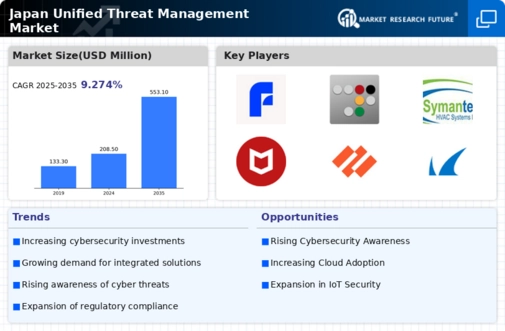Increasing Cybersecurity Threats
The unified threat-management market in Japan is experiencing growth due to the rising frequency and sophistication of cyber threats. Organizations are increasingly targeted by ransomware, phishing, and advanced persistent threats, necessitating robust security solutions. In 2025, it is estimated that cybercrime could cost the global economy over $10 trillion annually, prompting Japanese businesses to invest in comprehensive security measures. This trend indicates a strong demand for unified threat-management solutions that can provide integrated protection against diverse threats. As companies seek to safeguard sensitive data and maintain operational integrity, the Unified Threat Management Market is likely to expand significantly, driven by the need for enhanced security protocols.
Adoption of Remote Work Practices
The shift towards remote work in Japan has created new challenges for cybersecurity, thereby impacting the Unified Threat Management Market. As employees access corporate networks from various locations, the risk of security breaches increases. In 2025, it is anticipated that remote work will account for over 30% of the workforce in Japan, necessitating robust security solutions to protect remote access points. Unified threat-management systems offer integrated security features that can effectively manage these risks, making them essential for organizations adapting to this new work environment. Consequently, the demand for such solutions is likely to surge as companies prioritize securing their remote operations.
Regulatory Compliance Requirements
Japan's regulatory landscape is evolving, with stricter data protection laws and compliance requirements influencing the Unified Threat Management Market. The Personal Information Protection Act (PIPA) mandates organizations to implement adequate security measures to protect personal data. As businesses strive to comply with these regulations, the demand for unified threat-management solutions is expected to rise. In 2025, it is projected that compliance-related investments in cybersecurity could reach $3 billion in Japan. This regulatory pressure compels organizations to adopt comprehensive security frameworks, thereby driving growth in the unified threat-management market as firms seek to avoid penalties and reputational damage.
Growing Awareness of Cybersecurity Risks
There is a notable increase in awareness regarding cybersecurity risks among Japanese businesses, which is positively influencing the Unified Threat Management Market. As high-profile data breaches make headlines, organizations are recognizing the importance of proactive security measures. In 2025, surveys indicate that over 70% of Japanese companies plan to enhance their cybersecurity budgets, reflecting a shift in mindset towards prioritizing security. This heightened awareness drives the demand for unified threat-management solutions that offer comprehensive protection against evolving threats. As businesses seek to mitigate risks and protect their assets, the unified threat-management market is poised for substantial growth.
Technological Advancements in Security Solutions
Technological advancements are playing a crucial role in shaping the Unified Threat Management Market in Japan. Innovations in artificial intelligence, machine learning, and automation are enhancing the capabilities of security solutions, making them more effective against sophisticated threats. In 2025, it is projected that the market for AI-driven security solutions will grow by 25%, indicating a strong trend towards integrating advanced technologies in unified threat-management systems. These advancements enable organizations to respond to threats more swiftly and efficiently, thereby increasing the attractiveness of unified threat-management solutions. As technology continues to evolve, the market is likely to witness significant growth driven by these innovations.























Leave a Comment